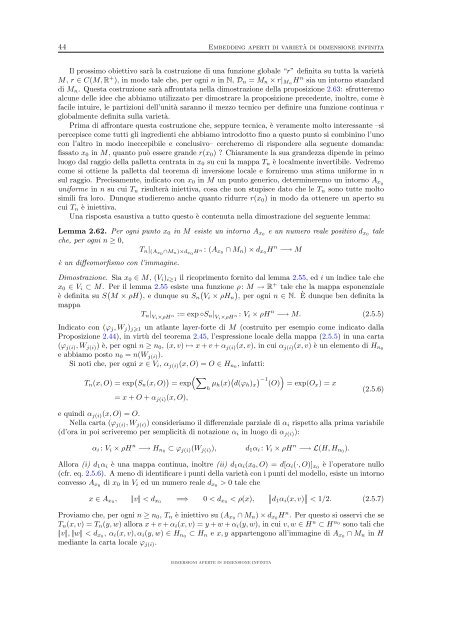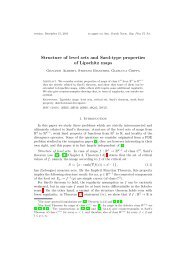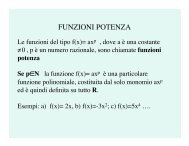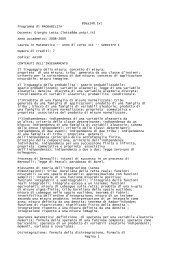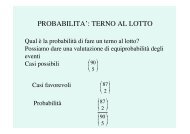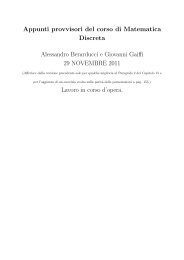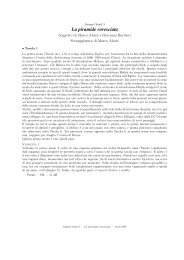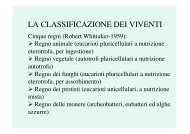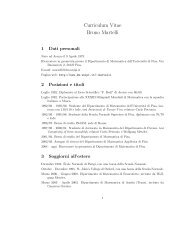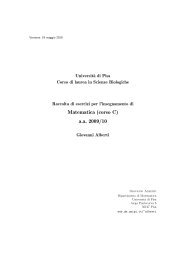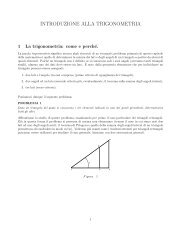Immersioni aperte in dimensione infinita - Dipartimento di Matematica
Immersioni aperte in dimensione infinita - Dipartimento di Matematica
Immersioni aperte in dimensione infinita - Dipartimento di Matematica
You also want an ePaper? Increase the reach of your titles
YUMPU automatically turns print PDFs into web optimized ePapers that Google loves.
44 Embedd<strong>in</strong>g aperti <strong>di</strong> varietà <strong>di</strong> <strong><strong>di</strong>mensione</strong> <strong>in</strong>f<strong>in</strong>ita<br />
Il prossimo obiettivo sarà la costruzione <strong>di</strong> una funzione globale “r” def<strong>in</strong>ita su tutta la varietà<br />
M, r ∈ C(M, R + ), <strong>in</strong> modo tale che, per ogni n <strong>in</strong> N, Dn = Mn × r|MnH n sia un <strong>in</strong>torno standard<br />
<strong>di</strong> Mn. Questa costruzione sarà affrontata nella <strong>di</strong>mostrazione della proposizione 2.63: sfrutteremo<br />
alcune delle idee che abbiamo utilizzato per <strong>di</strong>mostrare la proposizione precedente, <strong>in</strong>oltre, come è<br />
facile <strong>in</strong>tuire, le partizioni dell’unità saranno il mezzo tecnico per def<strong>in</strong>ire una funzione cont<strong>in</strong>ua r<br />
globalmente def<strong>in</strong>ita sulla varietà.<br />
Prima <strong>di</strong> affrontare questa costruzione che, seppure tecnica, è veramente molto <strong>in</strong>teressante –si<br />
percepisce come tutti gli <strong>in</strong>gre<strong>di</strong>enti che abbiamo <strong>in</strong>trodotto f<strong>in</strong>o a questo punto si comb<strong>in</strong><strong>in</strong>o l’uno<br />
con l’altro <strong>in</strong> modo <strong>in</strong>eccepibile e conclusivo– cercheremo <strong>di</strong> rispondere alla seguente domanda:<br />
fissato x0 <strong>in</strong> M, quanto può essere grande r(x0) ? Chiaramente la sua grandezza <strong>di</strong>pende <strong>in</strong> primo<br />
luogo dal raggio della palletta centrata <strong>in</strong> x0 su cui la mappa Tn è localmente <strong>in</strong>vertibile. Vedremo<br />
come si ottiene la palletta dal teorema <strong>di</strong> <strong>in</strong>versione locale e forniremo una stima uniforme <strong>in</strong> n<br />
sul raggio. Precisamente, <strong>in</strong><strong>di</strong>cato con x0 <strong>in</strong> M un punto generico, determ<strong>in</strong>eremo un <strong>in</strong>torno Ax 0<br />
uniforme <strong>in</strong> n su cui Tn risulterà <strong>in</strong>iettiva, cosa che non stupisce dato che le Tn sono tutte molto<br />
simili fra loro. Dunque stu<strong>di</strong>eremo anche quanto ridurre r(x0) <strong>in</strong> modo da ottenere un aperto su<br />
cui Tn è <strong>in</strong>iettiva.<br />
Una risposta esaustiva a tutto questo è contenuta nella <strong>di</strong>mostrazione del seguente lemma:<br />
Lemma 2.62. Per ogni punto x0 <strong>in</strong> M esiste un <strong>in</strong>torno Ax0 e un numero reale positivo dx0 tale<br />
che, per ogni n ≥ 0,<br />
Tn| (Ax0 ∩Mn)×dx 0 H n : (Ax0 ∩ Mn) × dx0 Hn −→ M<br />
è un <strong>di</strong>ffeomorfismo con l’immag<strong>in</strong>e.<br />
Dimostrazione. Sia x0 ∈ M, (Vi)i≥1 il ricoprimento fornito dal lemma 2.55, ed i un <strong>in</strong><strong>di</strong>ce tale che<br />
x0 ∈ Vi ⊂ M. Per il lemma 2.55 esiste una funzione ρ: M → R + tale che la mappa esponenziale<br />
è def<strong>in</strong>ita su S M × ρH <br />
, e dunque su Sn Vi × ρHn , per ogni n ∈ N. È dunque ben def<strong>in</strong>ita la<br />
mappa<br />
Tn| Vi×ρH n := exp ◦Sn| Vi×ρH n : Vi × ρH n −→ M. (2.5.5)<br />
In<strong>di</strong>cato con (ϕj, Wj)j1 un atlante layer-forte <strong>di</strong> M (costruito per esempio come <strong>in</strong><strong>di</strong>cato dalla<br />
Proposizione 2.44), <strong>in</strong> virtù del teorema 2.45, l’espressione locale della mappa (2.5.5) <strong>in</strong> una carta<br />
(ϕj(i), Wj(i)) è, per ogni n ≥ n0, (x, v) ↦→ x + v + αj(i)(x, v), <strong>in</strong> cui αj(i)(x, v) è un elemento <strong>di</strong> Hn0<br />
e abbiamo posto n0 = n(Wj(i)). Si noti che, per ogni x ∈ Vi, αj(i)(x, O) = O ∈ Hn0 , <strong>in</strong>fatti:<br />
Tn(x, O) = exp Sn(x, O) <br />
= exp<br />
h µh(x) <br />
−1(O)<br />
d(ϕh)x = exp(Ox) = x<br />
= x + O + αj(i)(x, O),<br />
(2.5.6)<br />
e qu<strong>in</strong><strong>di</strong> α j(i)(x, O) = O.<br />
Nella carta (ϕ j(i), W j(i)) consideriamo il <strong>di</strong>fferenziale parziale <strong>di</strong> αi rispetto alla prima variabile<br />
(d’ora <strong>in</strong> poi scriveremo per semplicità <strong>di</strong> notazione αi <strong>in</strong> luogo <strong>di</strong> α j(i)):<br />
αi : Vi × ρH n −→ Hn0 ⊂ ϕ j(i)(W j(i)), d1αi : Vi × ρH n −→ L(H, Hn0).<br />
Allora (i) d1αi è una mappa cont<strong>in</strong>ua, <strong>in</strong>oltre (ii) d1αi(x0, O) = d[αi(·, O)]x0 è l’operatore nullo<br />
(cfr. eq. 2.5.6). A meno <strong>di</strong> identificare i punti della varietà con i punti del modello, esiste un <strong>in</strong>torno<br />
convesso Ax0 <strong>di</strong> x0 <strong>in</strong> Vi ed un numero reale dx0 > 0 tale che<br />
x ∈ Ax0 , |v | < dx0 =⇒ 0 < dx0 < ρ(x),<br />
<br />
d1αi(x, v) < 1/2. (2.5.7)<br />
Proviamo che, per ogni n ≥ n0, Tn è <strong>in</strong>iettivo su (Ax0 ∩ Mn) × dx0 Hn . Per questo si osservi che se<br />
Tn(x, v) = Tn(y, w) allora x + v + αi(x, v) = y + w + αi(y, w), <strong>in</strong> cui v, w ∈ H n ⊂ H n0 sono tali che<br />
|v |, |w | < dx0, αi(x, v), αi(y, w) ∈ Hn0 ⊂ Hn e x, y appartengono all’immag<strong>in</strong>e <strong>di</strong> Ax0 ∩ Mn <strong>in</strong> H<br />
me<strong>di</strong>ante la carta locale ϕ j(i).<br />
IMMERSIONI APERTE IN DIMENSIONE INFINITA


